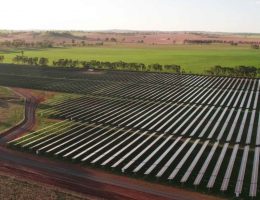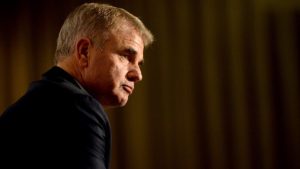Even before he entered parliament, federal energy minister Angus Taylor was on a mission to stop the Australian wind and solar industry.
He appeared, and was hailed a hero, at an anti-wind rally hosted by the backers of an anonymous and rather nasty website called “Stop These Things”, and after he entered parliament in 2013 he fought unsuccessfully to have the renewable energy target scrapped altogether. Instead, it was merely chopped by a third.
As a newly appointed energy minister last year, Taylor declared there was already too much wind and solar in the Australian grid, and claimed that having too much wind and solar would lead to the “de-industrialisation” of Australia’s economy.
And despite the Coalition repeatedly crowing about the “world-leading” amounts of wind and solar constructed in Australia – brought about, of course, under a policy it had tried to destroy, Taylor is back to saying there is too much variable renewables in the system, against all the expert advice to the contrary.
“We have crossed the threshold,” Taylor told the AFR energy summit this week. “If you look at the last month we have consistently been above 25 per cent intermittent renewables.”
Taylor’s message is that the system can’t cope, and that new wind and solar should be stopped in its tracks, and what he calls the “only solutions” available to balance their output – coal, gas and hydro – built or propped up to maintain grid reliability. Batteries, he dismisses, have only a role to play in minor markets like frequency control.
It’s palpable nonsense of course, and truly frightening that the country’s federal energy minister should hold such views, either through prejudice or ignorance.
South Australia’s grid is operating just fine at more than 50 per cent wind and solar, and the local Liberal state government has plans to more than double that, and go “net 100 per cent renewables.” The Australian Energy Market Operator is busy putting together a 20-year blueprint that will show how Australia can transition its grid to a very high level of renewables.
Last year, chief scientist Alan Finkel released a report by the Australian Council of Learned Academies (ACOLA) that showed little storage was needed until wind and solar reached between 35 per cent to 50 per cent share of the grid. The report by experts was rejected as “eco-evangelism” by the Coalition.
Every big utility in Australia accepts that Australia is going to switch to renewables, it’s just a matter of when, and they just wish that the federal Coalition government would get out of the industry’s way and let the experts get on with it.
And as if to underline that point, Jim Robo, the head of NextEra, an American utility so big it is nearly the size (in capacity and market worth) to the entire Australia grid, said last week he saw no problems with having 70-75 per cent renewables, with a minimum amount of storage, and predicted the end of coal within a decade.
Robo focused on battery storage, noting the combination of wind and/or solar with battery storage was cheaper than even existing gas coal or his company’s own nuclear plants. Australia’s Coalition government won’t even acknowledge that battery storage works.
 Taylor, though, is now in a position where he can effectively “stop these things”. Not by anything so crude as nixing individual projects, or banning the technology, but by creating so much investor uncertainty by repeated government intervention in the markets, and giving heavy backing to the government’s own pet projects that crowd others out of the market.
Taylor, though, is now in a position where he can effectively “stop these things”. Not by anything so crude as nixing individual projects, or banning the technology, but by creating so much investor uncertainty by repeated government intervention in the markets, and giving heavy backing to the government’s own pet projects that crowd others out of the market.
This week, the Grattan Institute noted that the government’s decision to back Snowy 2.0 pumped hydro scheme, and to propose underwriting for up to 12 different coal, gas and pumped hydro projects, would effectively bring competing private investments to a halt.
That call was echoed by the head of the Energy Security Board, Kerry Schott, who said Taylor’s intervention in the market, from setting price caps to its own underwriting program, would stop private investment. For good measure, she labelled Taylor’s favoured coal technologies, and the units he is trying to keep open, as dinosaurs.
Schott’s comments are remarkable because they reflect growing frustration at the institutional level with the federal government. Schott is no rabid environmentalist or renewable evangelist, but she listens to experts, and the experts have been crystal clear.
Solar and wind projects are facing other roadblocks, created by a lack of planning for which the federal government, and bodies such as the Australian Energy Market Commission, are directly responsible.
They have failed to ensure that the transmission investment has been made, or that the rules have been changed to reflect the technologies that will dominate the modern grid. This is because they refused to listen or believe the experts (the AEMC has mostly been made up of economists and lawyers).
There are efforts to remove the blockages, and the Integrated System Plan proposed by AEMO is a key component of that. But Taylor refuses to play ball – he has only recently called for a COAG Energy Council meeting – in late November – the first in a year. No agenda has been released. And he has reportedly refused to accept the basis of the ISP, disputing its costings and other assumptions.
The most common description of Taylor by those who have met him is that he likes to think he is the smartest person in the room. Or, as Victoria’s energy minister Lily D”Ambrosio told the AFR summit: “The only person who thinks Angus Taylor is doing a good job is Angus Taylor.”
Nothing and no-one has changed Taylor’s mind. Certainly not the experts at AEMO with the ISP, nor chief scientist Alan Finkel. (Apart from rejecting the ACOLA report on renewables integration, Taylor has also been credited with leading the Coalition fight against Finkel’s Clean Energy Target).
AGL has given seven years notice of its closure of Liddell and provided detailed costings of the alternatives. Taylor rejects these, and the AEMO assessment of what is needed to replace it. Taylor calls it “proselytising”.
“Some vague hope of transmission, intermittent generation and demand management filling the gap is not good enough,” Taylor said this week. “For too long this industry has suffered from the triumph of hope over reality. Not this time.”
Taylor’s claim that more renewables equals less reliability are complete nonsense. South Australia, after fixing its grid management issues, has been running for more than two years with more than 50 per cent wind and solar, and without the problems faced by coal-dominated Victoria, NSW and Victoria.
The state Liberal government has cast a plan for “net 100 per cent renewables.” The introduction of pumped hydro and more batteries, along with synchronous condensers, means that the role played by gas in that scenario will be minimal.
At the same time, big industrial players are making a mockery of Taylor’s claim that too much wind and solar leads to “de-industrialisation”.
They say that the opposite will happen, and that cheap wind and solar is the key to Australia’s future prosperity, either through “green hydrogen” exports that will replace the LNG industry, or “green metals”, with wind and solar providing the cheap power for added value industries.
A prime example of this is using cheap wind and solar to allow refining and processing of manganese metals, as proposed by Element25 for its Butcherbird project in the Pilbara, or for “green hydrogen” in steel making.
And while Taylor claims there is too much wind and solar in the system, a consortium of Macquarie Group, Vestas, and CWP is proposing a 15GW wind and solar facility in the Pilbara; global giant Siemens and partners are looking at a 5GW wind and solar facility closer to Perth; and billionaire Mike Cannon-Brookes is backing a 10GW solar plant in the Northern Territory.
ARENA chief executive Darren Miller speaks of the possibilities of 700GW of wind and solar – or 600-700 per cent of Australia’s electricity needs – being built in Australia for the “green hydrogen and “green metals” prospects. He says they should all be linked to the country’s main grid to ensure cheap power and no supply gaps.
Economist Professor Ross Garnaut and others have talked of the same opportunities. We will hear more about this when Finkel unveils the details of his national hydrogen strategy when the state and federal energy ministers finally get to meet in Perth late next month.
Taylor, though, remains convinced he is right and everyone else is wrong. During the election campaign, he was the source of some stupendous nonsense about electric vehicles, their range, their costs, their impacts and their charging. And he’s still talking nonsense about wind and solar.
Will Taylor be successful in his one man mission to stop these things?
Time will tell. The best that could have been hoped for from Taylor was that he and the Coalition government would get out of the way, and let the institutions put in the relevant plans and frameworks for the energy transition, and let investors get on with their work.
But Taylor won’t get out of the way. His refusal to meet with energy ministers for nearly a year, his refusal to endorse the ISP, his efforts to interfere in Liddell, his interference in markets, and the Coalition’s backing of Snowy 2.0 and his own pet underwriting program, the Underwriting New Generation Investments, are all hindering progress.
UNGI was supposed to be a matter of extreme urgency when it was first dreamed up last September. But after drawing up a list of 12 potential projects, not much has happened since the government surprised itself by winning the election. Taylor understands that the uncertainty will dampen any sort of investment.
There is a phenomenal pipeline of investment – around 100GW in total according to AEMO – and while many projects are “announced”, most are only getting to development approval stage, few are getting to financial close because of the uncertainty.
State targets may underpin some investment, but Victoria is stymied for the moment by transmission issues, a result of bad planning by the key energy institutions, and the Queensland government seems happy to have a pause in wind and solar investment to appease the unions.
Taylor is not quite a one-man band. He views are shared by Coalition MPs, the Murdoch media, and prominent donors like coal magnate Trevor St Baker, and even by ACCC chair Rod Sims, his mentor at Port Jackson Partners.
But do we really want to stop these things? All the experts tell us will result in delays, added cost and less reliability. Let’s just stop this madness.











